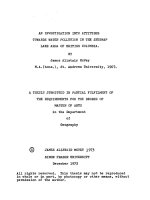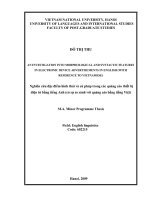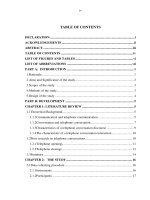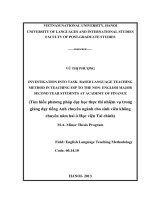An investigation into nominalization and grammatical metaphor in “happy teachers change the wor
Bạn đang xem bản rút gọn của tài liệu. Xem và tải ngay bản đầy đủ của tài liệu tại đây (750.45 KB, 134 trang )
THE UNIVERSITY OF DANANG
UNIVERSITY OF FOREIGN LANGUAGE STUDIES
GIÃ THỊ TUYẾT NHUNG
AN INVESTIGATION INTO NOMINALIZATION
AND GRAMMATICAL METAPHOR IN
—HAPPY TEACHERS CHANGE THE WORLD” BY
THICH NHAT HANH AND KATHERINE WEARE
MASTER THESIS IN
LINGUISTICS AND CULTURAL STUDIES
OF FOREIGN COUNTRIES
Da Nang, 2020
THE UNIVERSITY OF DANANG
UNIVERSITY OF FOREIGN LANGUAGE STUDIES
GIÃ THỊ TUYẾT NHUNG
AN INVESTIGATION INTO NOMINALIZATION
AND GRAMMATICAL METAPHOR IN
“HAPPY TEACHERS CHANGE THE WORLD” BY
THICH NHAT HANH AND KATHERINE WEARE
Major
Code
: ENGLISH LINGUISTICS
:
822.02.01
MASTER THESIS IN
LINGUISTICS AND CULTURAL STUDIES
OF FOREIGN COUNTRIES
SUPERVISOR: Assoc. Prof. Dr. PHAN VĂN HÒA
Da Nang, 2020
1
STATEMENT OF AUTHORSHIP
Except where reference is made in the text of the thesis, this thesis contains no
material published elsewhere or extracted in whole or in part from a thesis by which
I have qualified for or been awarded another degree or diploma.
No other person’s work has been used without due acknowledgements in the
thesis.
This thesis has not been submitted for the award of any degree or diploma in
any other tertiary institution.
Da Nang, July 2020
Giã Thị Tuyết Nhung
ACKNOWLEDGEMENT
My special thanks, first of all, are extended to the University of Foreign
Language Studies - Danang University, especially my lecturers for teaching me so
enthusiastically, dedicatedly and preparing me for the completion of the research.
Secondly, I would like to express my deepest gratitude to my research
supervisor, Assoc. Prof. Dr. Phan Van Hoa for his selecting the research topic,
providing me with a lot of valuable documents. From the bottom of my heart, I
would like to say that without his constant encouragement, timely feedback and
constructive comments I can not finish my thesis.
Thirdly, I would like to send my sincere thanks to great Zen Master Thich
Nhat Hanh and Professor Katherine Weare, coauthors of „Happy Teachers Change
the World’- a masterpiece from which I am honoured to „collect’ not only the
treasure of data but also the endless inspiration and energy for my research.
Last but not least, I would like to give my great love to the Education Board
of Truong Chinh High School, Kontum,where I have been teaching for 10 years and
my family for their endless spritual and material support in the process of my
learning and doing the research.
ABSTRACT
The study aims at analysing and clarifying the processes of nominalizing
word classes and nominal functions. From doing so will discover the ways of
expressing the types of Grammatical Metaphor including Ideational Grammatical
Metaphor, Interpersonal Grammatical Metaphor, and Textual Grammatical Metaphor.
The analysis and explanations of the study are based on the new points of view of
Functional Grammar introduced by Halliday (1985, 2004, 2014). The book “Happy
Teachers Change The World” by Zen Master Thích Nhất Hạnh and Educator Dr.
Katherine Weare (2017), is used as the source of data collected and the evidences for
the existence and the functions of Nominalization in Non- Grammatical Metaphor
and Nominalization in Grammatical Metaphor cases to affirm again that
Nominalization has it own properties that are different from Grammatical Metaphor.
However, Nominalization is also a part of Grammatical Metaphor.The investigation
reveals that Nominalization and Grammatical Metaphor occupies a large number:
507 samples in which Nominalization accounts for 262 samples, and Grammatical
Metaphor occupies 245 samples including Ideational Grammatical Metaphor,
Interpersonal Grammatical Metaphor, and Textual Grammatical Metaphor.Based on
Halliday's Functional Grammar framework, the thesis suggests some applications of
the research results to English learning, especially in enriching vocabulary and
improving writing skills including academic writing.
TABLE OF CONTENTS
STATEMENT OF AUTHORSHIP ....................................................................... i
ACKNOWLEDGEMENT .................................................................................... ii
ABSTRACT ........................................................................................................... iii
TABLE OF CONTENTS....................................................................................... iv
ABBREVIATIONS ................................................................................................ vi
LIST OF TABLES .................................................................................................
vii
LIST OF FIGURES ............................................................................................... ix
Chapter One. INTRODUCTION .........................................................................1
1.1. RATIONALE ..................................................................................................1
1.2. AIMS AND OBJECTIVES ............................................................................4
1.2.1. Aims of the study....................................................................................4
1.2.2. Objectives .............................................................................................5
1.3. RESEARCH QUESTIONS..............................................................................5
1.4. SCOPE OF THE STUDY ...............................................................................5
1.5. SIGNIFICANCE OF THE STUDY..................................................................6
1.6. ORGANIZATION OF THE STUDY ..............................................................6
Chapter Two. LITERATURE REVIEW AND THEORETICAL
BACKGROUND .....................................................................................................7
2.1. A REVIEW OF PREVIOUS STUDIES RELATED TO THE TOPIC ............7
2.2. THEORETICAL BACKGROUND ................................................................10
2.2.1. Functional Grammar.............................................................................10
2.2.2. Nominalization .....................................................................................11
2.2.3. Grammatical Metaphor.........................................................................19
2.3. INTRODUCTION TO AUTHORS AND BOOK “HAPPY TEACHERS
CHANGE THE WORLD”.......................................................................................36
2.3.1. Thich Nhat Hanh ..................................................................................36
2.3.2. Katherine Weare ...................................................................................36
2.3.3. The book “Happy Teachers Change The World”...................................37
2.4. SUMMARY ...................................................................................................37
Chapter Three. RESEARCH DESIGN AND METHODOLOGY....................39
3.1. RESEARCH .................................................................................................39
3.2. SAMPLING ..................................................................................................39
3.3. DATA COLLECTION....................................................................................39
3.4. DATA ANALYSIS ........................................................................................40
3.5. PROCEDURES..............................................................................................41
3.6. RELIABILITY AND VALIDITY .................................................................41
Chapter Four. FINDINGS AND DISCUSSIONS ..............................................42
4.1. NOMINALIZATION TYPES USED IN “HAPPY TEACHERS CHANGE
THE WORLD”.......................................................................................................42
4.1.1. Simple Nominalization .......................................................................43
4.1.2. Complex Nominalization......................................................................52
4.1.3. Summary...............................................................................................58
4.2. GRAMMATICAL METAPHOR EXPRESSED THROUGH
NOMINALIZATION IN” HAPPY TEACHERS CHANGE THE WORLD”.........60
4.2.1. Ideational Grammatical Metaphor.........................................................62
4.2.2. Interpersonal Grammatical Metaphor....................................................79
4.2.3. Textual Grammatical Metaphor ...........................................................93
4.2.4. Summary...............................................................................................97
Chapter Five. CONCLUSION ............................................................................100
5.1. CONCLUSION ............................................................................................100
5.2. IMPLICATIONS...........................................................................................103
5.2.1. Implication for teachers ......................................................................105
5.2.2. Implication for learners .......................................................................106
5.3. LIMITATIONS OF THE THESIS AND FURTHER STUDY ........................106
5.3.1. Limitations of the thesis ......................................................................106
5.3.2. Suggestions for Further Researches ....................................................107
REFERENCES ....................................................................................................4
QUYẾT ĐỊNH GIAO ĐỀ TÀI LUẬN VĂN (Bản sao)
ABBREVIATIONS
Adjective
Adj
English as a Second
Language
ESL
Grammatical Metaphor
GM
Noun
N
Nominalization NML
Subject
S
Systemic Functional
Linguistics
SFL
Systemic Functional
Grammar
SFG
Verb
V
LIST OF TABLES
Number
Name of Table
of Tables
2.1.
2.2.
Five types of nominalizations
Congruent Mode of a Figure (Halliday and Matthiessen
Page
12
16
2.3.
1999)
Metaphorical Mode of a Figure (element)
2.4.
Ideational Grammatical Metahor Types (Ravelli,1988)
26
2.5.
Shift to „thing’ (Derewianka 2008)
28
16
Major categories of metaphor of modality (Halliday 1994:
2.6.
354-363)
31
2.7.
Four types of textual metaphor provided by Martin (1992)
35
4.1.
Nominalization by using suffix- derivation (a)
44
4.2.
Nominalization by using suffix- derivation (b)
45
4.3.
Nominalization by using conversion (a)
46
4.4.
Nominalization by using conversion (b)
46
4.5.
Nominalization by using final syllable shift
47
4.6.
Nominalization by using Adjectives
48
4.7.
Nominalization by using Adverbs
49
4.8.
Nominalization by using both Nouns and Adjectives
49
4.9.
Nominalization by using both Verbs and Adjectives
50
4.10.
Nominalization: Transformation, number and probability
51
4.11.
Nominal with Wh-
56
4.12.
Types of Complex Nominalization
57
4.13.
Types of Nominalization
58
4.14.
The transference from congruent to metaphorical mode -
61
Number
Name of Table
of Tables
Page
(Halliday1994)
4.15.
Nominalization of the Process (1)
63
4.16.
Nominal of the Process (2)
65
4.17.
Nominalization of the Process (3)
65
4.18.
Nominalization of the Process (4)
4.19.
Nominalization of the Circumstance
66
69
4.20.
Nominalization of the Attribute (1)
70
4.21.
Nominalization of the Attribute (2)
71
4.22.
Nominalization of the Attribute (3)
72
Three types of Nominalization in the clause: Number,
4.23.
Probability
73
4.24.
Nominalization of the Epithet (1)
74
4.25.
Nominalization of the Epithet (2)
74
4.26.
Nominalization with the Relator of Cause/ Effect
76
4.27.
Types of Ideational Grammatical Metaphor
77
4.28.
Metaphor of Modality (1)
87
4.29.
Types of Interpersonal GM
92
4.30.
Types of Textual GM
96
4.31.
Types of Grammatical Metaphor
98
LIST OF FIGURES
Number of
Name of Figure
Figure
Page
Congruent realization [Variation A] (Liart (2016, page17)
2.1.
2.2.
2.3.
3.1.
22
Incongruent realizations mapped onto the LexicoGrammar
Incongruent realizations mapped onto the lexicogrammar
Grammatical metaphor interpreted as semantic
23
23
40
4.1.
compound (According to Ravelli, 1985)
Occurrence of Simple Nominalization
4.2.
Occurrence of Complex Nominalization
58
4.3.
Occurrence of Nominalization
59
4.4.
Occurrence of Ideational Metaphor
78
4.5.
Occurrence of Interpersonal GM
92
4.6.
Occurrence of Textual GM
97
51
Occurrence of Ideational GM, Interpersonal GM and
4.7.
Textual GM
99
1
2
1.2. AIMS AND OBJECTIVES
1.2.1. Aims of the study
This study aims to:
- Investigate the types and the functions of NML in the book“Happy Teachers
Change The World” by Thich Nhat Hanh and Katherine Weare.
- Investigate GM including Ideational, Interpersonal and Textual ones used in”
Happy Teachers Change The World” by Thich Nhat Hanh and Katherine Weare.
- Find out the evidences to solve the research questions related below.
1.2.2. Objectives
Objectives required in this study are to:
- Identify the ways of expressing NML in “Happy Teachers Change The World” by
Thich Nhat Hanh and Katherine Weare” including identifying semantic and syntactic
features of NML and its functions.
- Point out Nominalizations used in different levels of word, phrase and
clause.
- Investigate and point out the ways of expressing GM in ” Happy Teachers
Change The World” including Ideational, Interpersonal and Textual ones, mainly from
the functions of NML.
- Collect NML and GM patterns used in the book and offer the suggestions to
learn and teach English.
1.3. RESEARCH QUESTIONS
To achieve the aims and the objectives mentioned above, the thesis writer
attempts to answer the following research questions:
1. What are the types and the functions of Nominalization used in the book”
Happy Teachers Change The World” by Thich Nhat Hanh and Katherine Weare?
2. How are Ideational GM, Interpersonal GM, and Textual GM expressed
through Nominalization in the book” Happy Teachers Change The World” written by
Thich Nhat Hanh and Katherine Weare?
3
1.4. SCOPE OF THE STUDY
This study investigates NML and GM including Ideational, Interpersonal and
Textual ones appearing in terms of words, phrases and clauses in the book “Happy
Teachers Change The World” by Thich Nhat Hanh and Katherine Weare. The analysis
mainly follows Halliday’s work “An Introduction to Function Grammar” by Halliday
(1985, 2004, 2014) and function-oriented others as the framework although NML and
GM from cognitive linguistics are, in the first time of researching, used to be
suggested to investigate.
1.5. SIGNIFICANCE OF THE STUDY
By analyzing NML and GM, the researcher hopes to contribute to
understanding the expressions and the functions of NML and GM in linguistic in
general. In particular, the findings of the study, to some extent, can provide more
evidence from NML and GM to understand texts more deeply and practise writing in a
better way. Besides, the thesis provides some updated information and necessary
knowledge for those who are interested in discovering and learning NML and GM
from the framework of Functional Grammar.
1.6. ORGANIZATION OF THE STUDY
This study consisted of five chapters as follows:
Chapter 1, the introduction of the study, includes the rationale, justification,
the scope of the study, the research questions, hypothesis, and organization of the
study.
Chapter 2, the literature review, presents the previous study related to the
study, giving a strong statement of the importance of this thesis and some theoretical
backgrounds of the study.
Chapter 3 is about the methods and procedures of the study. It will mention
the aims, the objectives of the study, then the methodology, the design of the research,
data collection, and data analysis.
Chapter 4: findings and discussion, includes two sections. The first section is
clarifying and analyzing the types of NML. The second one is analyzing the ways of
4
expressing the types of GM through NML including Ideational GM, Interpersonal
GM, and Textual GM.
Chapter 5 includes the conclusion and the implications, the limitations, and
suggestions for further study.
Chapter Two
LITERATURE REVIEW AND THEORETICAL BACKGROUND
2.1. A REVIEW OF PREVIOUS STUDIES RELATED TO THE TOPIC
The aims of this part are to point out issues which have been solved,
unresolved or uncompleted of documents relating directly to my research’s issues and
to give a general picture about the history and current situation of above researches.
From doing so will identify the thesis’s research problem correctly. All books and
articles are arranged in chronological order and content to emphasize the research’s
topic and then the types of GM are mentioned.
Since NML and GM were introduced, these language phenomena have
received a great deal of attention in linguistics. The notions of NML and GM have
been studied from a multitude of perspectives, which is shown clearly through many
following famous books and articles. Firstly, the terms NML and GM are explained
clearly through some books and articles such as in “An Introduction to Function
Grammar” introduced by Halliday (1985); he claims that GM is a type of metaphor
complementing the more commonly known lexical metaphor and has two types:
Ideational and Interpersonal GM. Martin, J.R. (1991) in “Functional and Systemic
Linguistics: Approaches and Uses” mentions to NML in science and humanities:
distilling knowledge and scaffolding text', it opens new perspectives in our
understanding of language. In” GM in Systemic Functional Linguistics: A
historiography of the introduction and initial study of the concept” Miriam Taverniers
(2003) presents the concept of GM. Liesbet Heyvaert (2003), on the other hand, in
paper “Nominalization as GM” proposes that NML is presented as a major resource
for
the
creation
of
“Metaphorical”
rather
than
“Typical”
or
congruent
5
Lexicalgrammatical realizations of semantic categories. Romero and Soria (2005)
suggest the approach Halliday’s notion of GM in “The Notion of GM in Halliday”.
Another paper of E. Romero (2006) is” GM and Lexical Metaphor: Different
perspectives on semantic variation”. This paper focusses on the concept of GM as it is
conceived of in the framework of systemic functional linguistics. Moreover, in “MIP:
A method for identifying metaphorically used words in discourse ” by Pragglejaz
Group (2007), the readers have chance to know about an explicit method that can be
reliably employed to identify metaphorically used words in discourse. Likewise,
Cassin Liardet (2016) in "WIL and GM: Elaborating The Theory presents an
elaborated framework for mapping learners’ development of nominalizations, one
prominent realization of the linguistic resource, GM. The writers of the paper "A study
of transfer directions in GM” are Quingshun He and Bingjun Yang (2019). The
purpose of the article is to address the transfer direction of GM within the theoretical
framework of Systemic Functional Linguistics and answer the question "whether there
is any possibility that bidirectional transfer could occur in or across the three types of
GMs: Ideational, Interpersonal and Textual Metaphors.
Secondly, GM phenomenon is also emphasized through the types of GM. In
article "Interpersonal GM as double scoping and double grounding” Miriam
Taverniers (2008) focuses on the notion of interpersonal GM as understood in
Halliday’s model of systemic functional linguisctic. In "Ideational GM in Scientific
Texts: A Hallidayan Perspective.” by Kazemmian (2013), the writer focuses on
Ideational GM, which includes process types and NML. This paper also adopts
Hallidayan Systemic Functional Grammar to pinpoint and analyze nominalization and
the role played by it. Besides, Yang (2018) in the article” Textual Metaphor Revisited”
has examined problems in the definition and identification of Textual Metaphor.
Additionally, there are many prior studies to NML and G.M done by
Vietnamese researchers such as Phan Văn Hòa (2008) in ” Ẩn dụ, ẩn dụ dụng học và
ẩn dụ ngữ pháp” has a deeply scientific view about GM. In this article, the writer
presents the current state of GM theory and its more relevant field for further research,
6
as well as the history and definitions of GM and problematic issues in the study of
Lexical-GM. Lê Thị Giao Chi (2014) in” GM in English official documentation”
provides insights into metaphorical modes of expression via Nominalizations -as- GM
in official texts. Another article of Lê Thị Giao Chi (2015) is “Hiện tượng về ẩn dụ
ngữ pháp trong Tiếng Anh và Tiếng Việt”. This article discusses G.M in English based
on the framework introduced by Halliday (1994). In “GM used in academic writing”
Phan Văn Hòa and Hồ Trịnh Quỳnh Thư (2018) approach the theory of GM and
present the types of G.M. This paper also synthesizes and filters which categories of
GM are used in academic writing, suggesting an application to writing teaching
process in school. The paper “Danh hóa và Ẩn dụ ngữ pháp từ góc nhìn ứng dụng
ngơn ngữ” by Phan Văn Hịa and Giã Thị Tuyết Nhung (2020) analyzes and clarifies
the processes of nominalizing word classes and nominal functions. Besides, writers
also discover the ways of expressing the types of GM: Ideational GM, Interpersonal
GM and Textual GM. The typical article about the types of GM is “Ideational
Metaphor in English and Vietnamese behavioral clauses” co - written by Phan Văn
Hòa and Nguyễn Thị Tú Trinh (2018). This paper focusses on interpreting the three
major types of typical patterns of Ideational grammar of behavioral clauses in English
and Vietnamese within the framework elaborated by Halliday and Matthiessen (2000,
2004), Martin et al as well as making their comparisons. Attention has been paid to
describe a wide range of construction and shift patterns of Ideational Metaphor
(transitivity metaphor) and the grammatical variants between congruent and
incongruent form applying to transitivity configurations in English and Vietnamese
behavioral clauses.
Besides, there are a range of master’s thesis investigating Nominalization or
GM such as” An investigation into NML in English and Vietnamese newspapers as
GM device in the Functional Grammar perspective”” by Nguyễn Văn Vui (2011).
The thesis carries out a detailed exploration of the functions, the operation of NML in
The Functional Grammar perspective. Phạm Thị Mai Phương (2014) in “An
Investigation into GM in Complete Ghost Stories by Charles Dickens” presents an
7
investigation into GM in stories.
The above mentioned articles, although not covering all the contents of the
long story involved, can give us a glimpse of a colorful and lively picture about NML
and GM. They are precious sources to supply a lot of necessary and important
information for my thesis in processing research. More importantly, although there are
a lot of investigations on NML or GM, it has not been any particular studies on the
NML and GM including Ideational GM, Interpersonal GM and Textual GM in the
same book. Therefore, “Happy Teachers Change the World” by co-authors Thich Nhat
Hanh and Katherine Wear is the first book chosen to research in both typical
phenomena of language: NML and GM.
2.2. THEORETICAL BACKGROUND
2.2.1. Functional Grammar
According to Martin, Matthiessen & Painter (1997), Functional Grammar is a
way of looking at grammar as it is used. It focuses on the development of grammatical
systems as a means for people to interact with each other. Givón (1968) describes that
Functional Grammar as “a set of strategies that one employs in order to produce
coherent communication”. Halliday (1994), who gave the birth of “An Introduction to
Functional Grammar” and” Systemic Functional Grammar”, explains that the term
systemic refers to the view of language as a network of systems or interrelated sets of
options for making meaning and the term functional means that language is as it is
because of what it has involved doing. Functional grammar is so-called because its
conceptual framework is a functional one. It is functional in three distinct senses: in its
interpretation (1) of texts, (2) of the system, and (3) of the elements of linguistic
structures. In the first sense, Functional Grammar is designed to account for how the
language is used. In the second sense, the fundamental components of meaning in
language are functional components. “If traditional grammar helps show each
component in the clause structure, systemic functional grammar focuses on the
functions of each component in relation to the clause functions” (Halliday &
Matthiessen, 2004/2014). According to Halliday (1994a), Grammar is considered to
8
be systems not as rules, on the basic that every grammatical structure involves a
choice from a describable set of options.
Therefore, language is a meaning potential. Halliday claimes that language is
functionally organized. All languages have resources for construing experience
(ideational function), for enacting human’s diverse and complex social relations
(interpersonal function) and for enabling these two kinds of meaning to come together
in coherent text (textual function), which are shown clearly in G.M. GM tends to
develop from Process toward Entity, leading to NML (Halliday 2004/2014)
2.2.2. Nominalization
NML has been noted as one of the fundamental properties of linguistics.
According to Bussmann (2000), NML refers to a creative formation process through
which words of all parts of speech could be converted into nouns. In other words,
NML is a transformation form other word-classes to nouns. Actually, in Bussmann’s
opinion, NML is mainly transferred form verbs and adjectives, because this
transformational process is relatively easier in comparison with other parts of speech,
such as conjunctions or prepositions. Matthews holds the same opinion like Bussmann
(2000: 244) who consideres NML as any process by which either a noun or a syntactic
unit functioning as a noun phrase, or any noun which is derived from any other kind
of unit such as a verb or an adjective. Similarly, Biber (1998) believes that NML is
nouns that are transformed from other word classes, mainly from verbs and adjectives,
which means nominalized words are derived from adding suffixes to verbs and
adjectives. As a whole, from the aforementioned definitions given by Bussmann,
Matthews and Biber, it can be concluded that they all considered NML as a kind of
transformational process which involves changes of word classes, especially
transferred from verbs and adjectives (Biber et al 2000; Crystal 2002). However, these
definitions still rest on lexical level, and the transformational process is restricted to
verbs and adjectives, hence, these definitions are somewhat limited and superficial
(Banks 2005). Among all these definitions, Halliday is the one who offered a general
and systematic theory of the phenomenon of NML. He states that “NML refers to the
9
phenomenon that any element or groups of element, phrase or clause can function as a
nominal structure” (Halliday, 2004: 358). His definition is a breakthrough in the field
of NML research, emphasizing functions of language and language in use. Instead of
equating NML with only a lexical item, Halliday defines NML as a grammatical
expression which contains a complex transformational process. Hence, it can be
concluded that except from Halliday, other researchers hold the same distinction that
NML is mainly transformed from verb or adjective. However, Halliday uses “any
element or groups of element” in his definition to broaden the range of NML from
merely the lexical level, and he analyzes NML from a higher level, which is syntactic
level, because according to him, NML functions as a noun or a nominal group in a
clause (Hu, 1989). Therefore, NML is not only a static word in a clause, and it
represents a dynamic transformational process in a clause.
Since the theoretical basis of NML is GM, more specifically, ideational
metaphor, as a result, Halliday classified NML in agreement with ideational metaphor.
Halliday (1996) identified the following five types of NML which reflected in
lexicogrammatical strata, as follows:
Table 2.1. Five types of nominalizations
Semantic functions
Grammatical functions
Lexicogrammatical class
(1) quality entity
epithet thing
adjective noun
(2) process entity
i event thing
verb noun
ii auxiliary thing
(3)circumstance entity
minor process thing
preposition noun
(4) relator entity
conjunctive thing
conjunction noun
(5) entity (expansion)
head modifier
noun various
These five types
belong to NML, and they are transformed from quality,
all
process, circumstance, relator, zero to entity respectively. Process NML is often
realized by the transference of a verb to a noun. Quality NML refers to any
nominalized word or word group derived from an adjective. Circumstance NML is
often realized by the transference of a prepositional or a prepositional phrase to a
noun. Relator NML refers to any nominalized word or word group derived from a
1
0
conjunctive. Zero NML is often realized by the transference of zero to a noun. As a
whole, these five types basically involve all the nominalizations under the framework
of GM.
Let’s analyze the types of NML in both Simple NML (lexical Nominalization)
and Complex NML (syntactic Nominalization) to understand deeply these
phenomena.
2.2.2.I. SimpleNominalization (LexicalNominalization)
In linguistics, Simple NML is the use of a verb, an adjective, or even an adverb
as the head of a noun phrase, with or without morphological transformation
(). There are many ways of forming Simple NML. One of the
effective means of Nominalization is affixing, typically suffixing. There are two main
kinds of English suffixes, de-verbal and de-adjectival nominalizers.
De-verbal nominalizers including -al (arrive-> arrival), -age (marry->
marriage),- ance (assist-> assistance),-ion(complete->completion),...
De-adjectival ones are -ance/ence (significant-> significance/different>difference), -ness(happy ->happiness), ....
Besides, there are some forms of NML such as using stress shift (e.g. con’tent (adj)„content (n)), definite article the (poor-> the poor) and so on.
Let’s look at the process of forming simple NML shown below
+ Action/ state Nominalization.
Most languages of the world make use of one or more devices for creating
action nouns from action verbs and state nouns from stative verbs or adjectives,
meaning the fact, the act, the quality, or occurrence of that verb or adjective. English
has a rich array of suffixes for this purpose, a few of which are illustrated
below:
(1)
create
—>
arrive
—>
creatio
n,
,
arrival
stupidit
stupid —> y,
quietne
quiet
—>
ss
An action/state noun can be formed
from a verb phrase consisting of a verb and
11
its object by reversing the order of the verb and the object. In English this strategy is
very productive with -ing.
(2)
drive a truck
trim a tree
hunt for a house
+ Agentive Nominalization
—
>
—
>
—
>
truckdriving,
treetrimming,
househunting
English has a productive process whereby action verbs can be made into nouns
meaning „one which “verbs”. We will refer to this process by the traditional label
„Agentive NML’ even though, strictly speaking, the noun need not be in an „agent’
relationship with the verb from which it is derived.
In English, for example, the suffix -er derives nouns meaning „one which
“verbs”’ from both agentive and nonagentive verbs:
(3) sing —> singer,
hear —> hearer,
However, this process is constrained in certain ways: for example, -er may not
be added to adjectives, and there are many stative verbs with which it cannot
occur:
(4)
tall
—>
*taller,
tall one,
fall
—> *faller,
one that
falls/fell
+ Instrumental Nominalization
There is a (typically morphological) process for forming from an action verb a
noun meaning „an instrument for “verbing”
English, of course, is similar: -er is used in both functions:
- Agentive:
(5)
sing —> singer,
- Instrumental:
(6)
slice
—>
slicer,
1
2
mow
—>
mower
+ Manner Nominalization
The action noun is indeterminate between a fact/occurrence interpretation and
a manner interpretation. English gerunds are like this:
(7) his walking can refer either to the fact or occurrence of his walking or to
the way he walks
+ Predictability and productivity
Languages typically show rather low predictability with respect to their noun
forming processes. In English, there is slightly more predictability. For example,
almost any polysyllabic verb ending in -ate will form its action noun by adding -ion,
as in create/creation. Similarly, most adjectives ending in -able or -ible form nouns in
-ity: respectable/respectability. But there is no way to predict, for example, that refuse
will take -al while accuse will take -ation or that true will add -th (to give truth)
To sum up, in English, Simple NML is often associated with specific
morphology but may Complex NML show morphological marker? Let’s follow the
next part.
2.2.2.2. Complex Nominalization (Syntactic Nominalization)
In syntax, NML is regarded as a way of transforming a clause structure into
NML where verbs and adjectives are turned into the head of a nominal group
(). The systemic-functional perspective on nominalizations is
closely tied up with the concept of GM: NML is presented as a major resource for the
creation of 'metaphorical' rather than 'typical' or 'congruent' lexicogrammatical
realizations of semantic categories. For example: A nominalized structure like the
cast's brilliant acting is thus viewed as the metaphorical counterpart of the clause the
cast acted brilliantly (Halliday & Matthiessen 1999: 229). Halliday (1994) also claims
that a piece of wording that is metaphorical has as it were an additional dimension of
meaning: it 'means' both metaphorically and congruently. Let’s consider the examples
by Halliday and Matthiessen (1999)
Congruent mode:
(8) (a) The enemy destroyed the city









